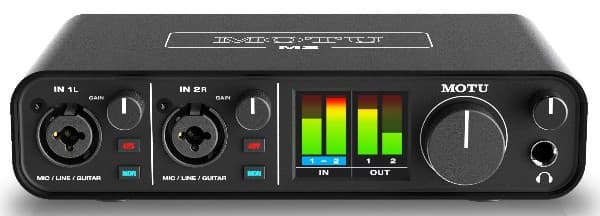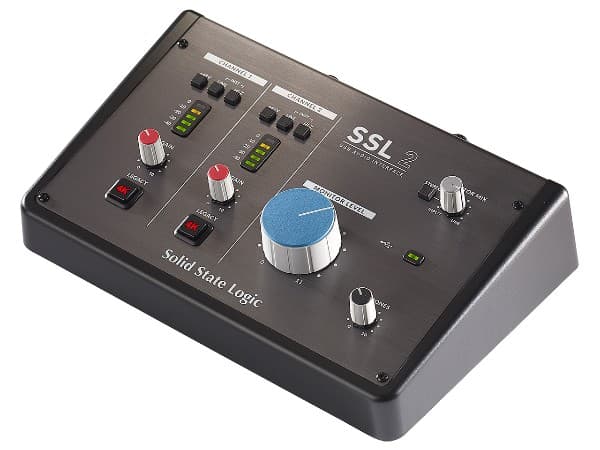At NAMM 2020 some new light audio interfaces were unveiled.
I mentioned these in the last podcast. But let’s put some of the details in writing.
Disclaimer: I haven’t used any of these. I just think they seem useful for light audio recording based on what I’ve read elsewhere about them.
Audient EVO 4 – US$129
Firstly, the EVO 4 from Audient is so new it isn’t even out yet!

This is due to launch in the first quarter of the year – you can follow it on Reverb, and get alerts when something happens with it.
But, still, it’s an impressive looking box, that crams a lot into it! I’m not even sure where to start!
OK, so, it has two combined XLR/jack plug inputs at the back, as well as an additional jack plug input in front.
One of the fanciest features on the EVO 4 is called Smartgain. You know how I always need to take a level when I’m recording? Well, Smartgain pretty much eliminates that.
It automatically sets the level of your microphone or instrument. Which is wild. It eliminates quite a bit of faffing.
Additionally, it has a feature called Loopback. This lets you record audio from your computer while you’re recording your mics and instruments. I don’t see mcuh use for it in light audio recording, but I’m sure it’s probably cool for somebody.
Everything is controlled by that big knob in the middle. Just press the button of what you want to adjust, then use the knob to tweak it.
Judging by the images, it seems to be made of plastic. And unfortunately, there’s no telling how durable that plastic might be.
It runs on passive power by USB 2.0. It’s not clear if it’ll work with Chromebooks, or Android phones.
MOTU M2 – US$169.95
Secondly, we have this little thing from MOTU.

While MOTU are no stranger to the world of audio interfaces, the M2 does show a shift in direction.
They usually put out pretty damn expensive gear. So, this marks an interesting change in direction.
It’s a tidy little box. I like that it’s USB-C powered. That suggests I could plug it into my phone… Hurrah!
As with the EVO 4, it has two combined XLR/jack plug inputs. It’s a fairly predictable layout: gain control for each input; a big knob for monitoring what you’re doing; and a separate volume for headphones.
I love that it has a metal chassis. Perfect for guerilla recording sessions on the subway, or wherever.
Additionally, it has stereo monitor level on the front. That’s ideal for mobile recording with BandLab, which doesn’t have a function in its app to get a level.
All in all, at this price, this is a very solid and tidy little unit.
Solid State Logic SSL 2 – US$229.99
Thirdly, here’s the Solid State Logic SSL 2.

Obviously, SSL are known for full-size, professional recording studio mixing desks. So this is a bit of a new direction for them.
But, also, they’re the type of brand who’ll make sure they’re doing this right.
The SSL 2 is pricier than other light audio interfaces around, but you’re paying for the brand, and for that brand to make a higher quality interface.
Let’s start with the basics.
The SSL 2 has two inputs, and two outputs. Certainly, it’s not just a clever name.
The inputs combine XLR and jack plugs. Just how we like them – it saves space.
Each input has a switch depending on if you’re using an instrument cable, XLR, or something phantom powered that needs some extra welly.
Similarly to the M2, it has a level monitor right in each channel, on the box, which I like.
It seems to have a metal chassis. Given the sometimes mobile nature of light audio recording, that’s definitely a plus.
I also like that it has a knob to balance between input and what you’re recording.
It’s main disctinctive feature is the 4k button, which claims classic analog sounds from this digital box.
However, it’s USB 2.0 powered. So, it doesn’t natively work with a phone. Although, I’m sure it could be figured out. But it’s likely a bit of a fiddle.
As usual, the specs say it’ll work with Windows and Mac – no mention of Chromebooks.
Conclusion: the best light audio interfaces right now
As can be seen, now is a great time to get into light audio recording.
For whatever reason, pro audio manufacturers – even big names of big expensive gear like MOTU and SSL – are tapping into the need for quality gear at a reasonable price, that takes up minimal real estate.
If I had to pick a winner for me, I think the MOTU M2 is the best all-rounder.
But, which of these light audio interfaces is right for you?
This is such a difficult question to answer.
The three listed here have such similar specs. Ultimately, it’s likely going to come down to your own budget.
If you found this helpful, subscribe on the right hand side of this page. You’ll be notified of new posts on Thursdays, inspiring you going into the weekend.
And share why you found it helpful. Because it helps us, and others!
Share your own light audio recording thoughts and experiences! There’s a Facebook group, a Subreddit, Twitter and Instagram.
Also, on LinkedIn, you can see the business-brain of Light Audio Recording at work.
Additionally, feel free to shoot me a coffee!
Finally, this is a music project, so we’re on Spotify – the playlist below starts with the most recent release and works backwards. So, feel free to follow us!
